Where do you go when you need to evaluate a pitcher? Fangraphs? Baseball Savant? Pitcher List (winks)? For many, it is a mix of all three. Attempting to track down the individual pitch type data can be a circus of clicking between tabs. One site gives you spin rate, another CSW%, etc., and suddenly you’re focusing more on switching between sites than actual analysis.
One of the easiest ways to get a solid number rating on a pitch is Baseball Savant’s run value. According to Baseball Savant, run value is defined as “the run impact of an event based on the runners on base, outs, ball and strike count.” This is valuable information, as it tells you objectively how well a pitch has performed. However, hitters can mash a good pitch and pitchers can get away with a mistake pitch, therefore creating imperfect information about the true value of a pitch. PLV, on the other hand, attempts to quantify how good a pitch actually is, regardless of the result. A longer explanation can be read here, but essentially it takes a variety of variables (release point, count, pitcher/batter handedness, velocity, movement, location, etc.) and tells us how good a specific pitch was.
This creates a contrast between these two pitch quantifiers. Run value looks at the pure result of the pitch, while PLV looks at the pure pitch itself. Inevitably, this will lead to players being valued differently based on where one looks as there will be disagreements. Michael Barker’s recent piece looking at underrated pitchers by PLV does a great job of identifying sleepers through their PLA (the ERA-adjusted version of PLV). This article will attempt to find sleepers by contrasting one’s run value with their PLV within each pitch type.
Fastballs
Hunter Greene: 87th Percentile PLV & 15th Percentile Run Value
Hunter Greene exemplified the wonderful world of pitcher development last year. Debuting at age 22 in his rookie season with the Reds, Greene took massive leaps forward as the year went on. While his 4.44 ERA wasn’t anything to write home about, the stuff, primarily led by the fastball, definitely is. Among qualified pitchers, Greene’s 99mph fastball ranked as the 10th hardest average pitch, which helped propel it to a very solid 5.07 PLV (equates to a 3.87 PLA). It also had an elite 14.6% SwStr and 71.7% Z-Contact%, meaning that batters often struggled to even touch this pitch at times. However, when hitters did get their bat on the ball, Greene struggled. His .371 xwOBA against was in the 38th percentile and a +5 run value ranked in the 15th percentile.
Two main problems exist for Greene: he pitches at Great American Ballpark (Coors-lite) for half of his games and he threw a lot of non-competitive pitches. However, he made a change in the last month of 2022 that has many people (me included!) believing in a breakout in 2023. Greene threw more fastballs on the edge of the zone and increased the spin rate on his fastball, and these changes reaped massive rewards.
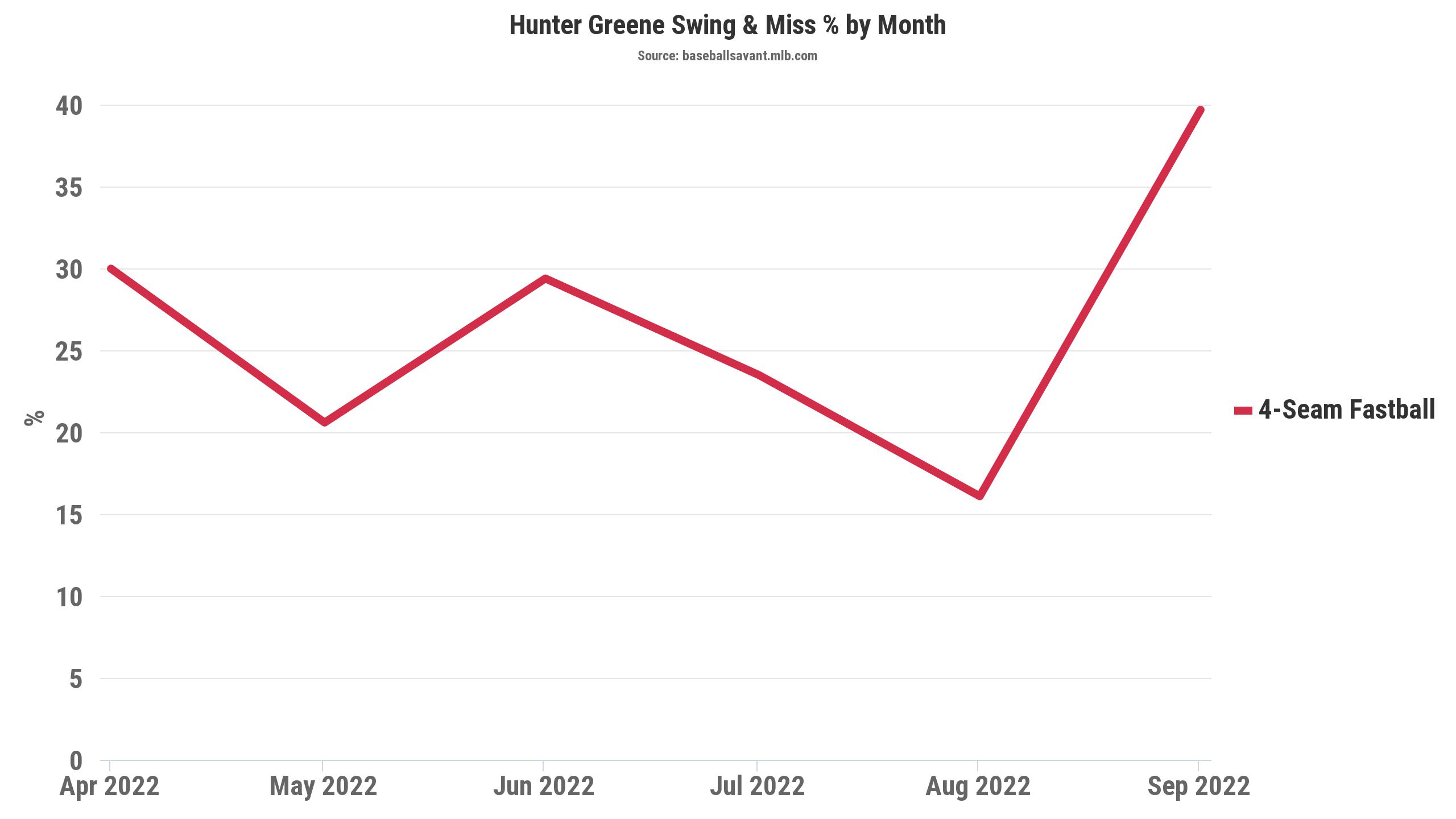
Greene’s whiffs increased massively en route to a 0.78 ERA in 23 IP in September. He’s proving that he has an elite pitch and with just a touch more command, the results can return value closer to his PLV prowess. Greene is a popular breakout pick, and rightfully so, he has all the tools to be an ace in 2023 and beyond.
José Suarez: 87th Percentile PLV & 11th Percentile Run Value
While not nearly as flashy a name as Greene, José Suarez also had a fastball that similarly underperformed in 2022. His 5.06 fastball PLV is essentially equal to Greene’s but saw more damage against it in 2022. Suarez’s fastball only sits in the mid-90s, but that is not the issue. Suarez’s fastball had a +6 run value with half as many pitches as Greene’s. Overall, Suarez put up a 3.96 ERA in 109 IP last season with a 22% K%. For Suarez, the biggest problem is that he struggled to locate the fastball against righties. Righties mashed the pitch for a .314 AVG and .396 wOBA, as the pitch often leaked over the middle of the plate. Suarez wanted to throw the pitch inside to jam righties, but he was punished for his mistake pitches.

Meanwhile, Suarez is a lot more comfortable with lefties and was able to live on the black more often. Left-handed hitters hit just .200 AVG and held a meager .322 wOBA against the fastball.

Statcast’s expected stats tell us that Suarez underperformed on the fastball against all hitters, which helps the case that Suarez’s fastball can perform closer to his PLV numbers rather than run value. The xwOBA on Suarez’s fastball was 26 points lower than the actual wOBA, indicating that the batted ball data says the pitch only should have been slightly below average rather than downright awful. While most of Suarez’s other offerings are about league average in terms of stuff, they all rated fairly well in Location+. Suarez was the only Angels starter (min 100 IP) to have all of his secondary pitches with a Location+ above 100. If he can avoid the heart of the zone with the fastball, Suarez could easily improve on his 3.96 2022 ERA and be a deep sleeper in drafts.
Ken Waldichuk: 73rd Percentile PLV & 11th Percentile Run Value
The last fastball sleeper I’ll mention is Ken Waldichuk, who is entering his first full MLB season as a 25-year-old with Oakland. Waldichuk held a 4.93 ERA in just 34 IP last season, but he has prospect pedigree and notably came to Oakland in the (maybe now infamous) Frankie Montas trade. Before we look at just his fastball, Kevin O’Brien does a fantastic breakdown of Waldichuk’s limited big league appearances that I highly recommend reading.
Waldichuk’s fastball had a 4.96 PLV, which ranks in the 73rd percentile while a +6 run value ranks in the 11th percentile. Again, sample size is important, as Waldichuk threw only 330 pitches—about half the number of fastballs Suarez threw (making this +6 run value a lot worse). Waldichuk has a similar problem to Hunter Greene. When he missed his location, it was a bad miss.
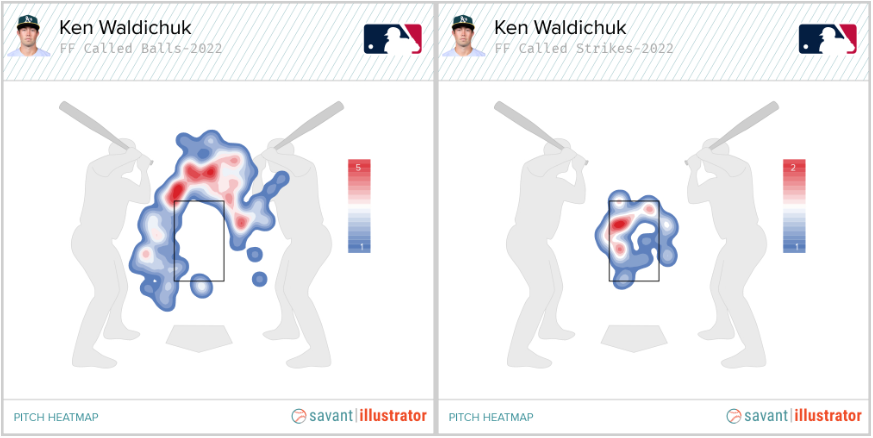
This image, taken from O’Brien’s piece, shows that Waldichuk had a lot of non-competitive pitches. This means two key things: hitters could wait for a fastball that was in the zone and there is a vast room for improvement on location. Hitters had a .311 AVG and .425 wOBA against the fastball, but the 4.96 PLV means that the pitch is promising. Additionally, Waldichuk was improving on the hard contact basically game by game. 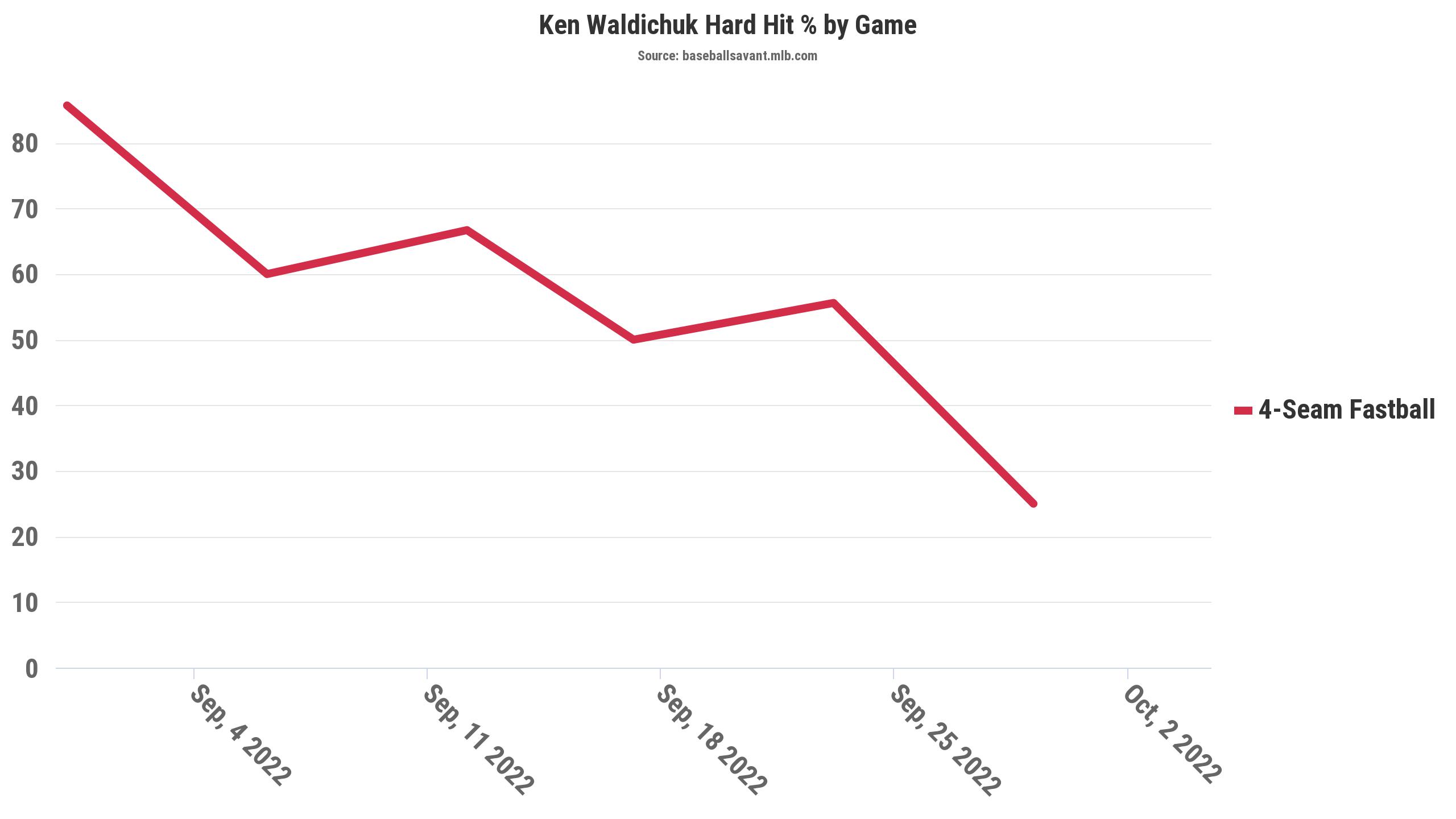
I don’t think that his HardHit% will continue to drop in 2023, it is safe to assume that there was a clear adjustment period early on in his time in Oakland. Furthermore, he also improved his strikeout and walk rates during this time as well. It does not hurt at all that he pitches in Oakland, which can definitely be a factor if his strikeout rate still hovers around 23-24%. Waldichuk is a prime late-flier pick as a guy that showed steady improvement in 2022 and can establish himself in a relatively open rotation in Oakland.
Breaking Balls
Yusei Kikuchi’s Slider: 80th Percentile PLV & 8th Percentile Run Value
Yusei Kikuchi’s first year in Toronto was one to forget: a 5.19 ERA and a Statcast page littered with Blue Jays-blue. Yet going into 2023, his success as a starter will be closely watched as he is a key piece that the Blue Jays need in order to compete with the Yankees atop the AL East (or at least until Ricky Tiedemann is ready to go). With a league-average fastball, Kikuchi’s struggles come from his slider: a .283 AVG and .408 wOBA against the pitch was near the worst in baseball.
Kikuchi uses his slider to make up for his poor fastball, which isn’t great usage of a pitch that should be getting whiffs.
| Pitch Type | Zone% | heLoc% | Swing% | O-Swing% |
|---|---|---|---|---|
| Fastball | 46.7% | 5.6% | 39.3% | 18.3% |
| Avg. Fastball | 49.2% | 7.3% | 47.8% | 26.4% |
| Slider | 47.1% | 9.4% | 61.3% | 48.9% |
| Avg. Slider | 40.6% | 5.9% | 46.3% | 32.0% |
Kikuchi is below average at throwing his fastball in the zone, but throws his slider in the zone 7% more than average. In line with that, Kikuchi’s slider ends up middle-middle (heLoc%) significantly more than the league average. There’s an even bigger contrast in the swing percentages though, which makes Kikuchi interesting. While hitters swing around 8% less on average on the fastball, they offer at the slider 15% more than the league average. This disparity also rings true in chase rate, suggesting that Kikuchi could thrive by throwing the slider as an out pitch, rather than as a strike pitch. Kikuchi throws the slider 18% of the time when he’s behind in the count, compared to the 8% league average.
PLV believes in the slider, but there are just too many poor pitches that hold it down.
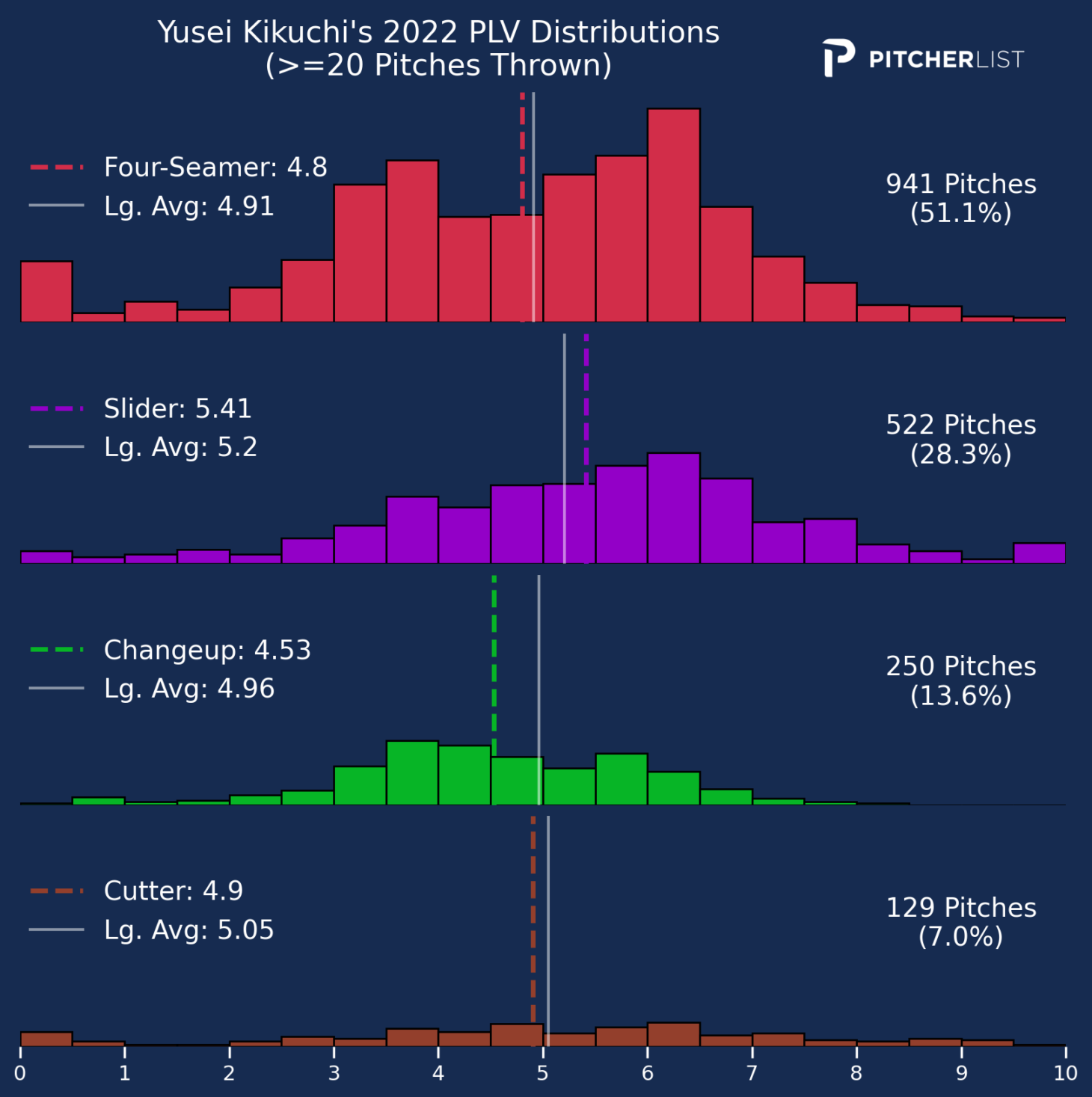
He probably is not on anyone’s radar as a useful fantasy starter going into 2023, but could provide some value if the slider gets tinkered with. It also helps that he gets the Royals and Tigers most likely to start in 2023, which could be a good way to ease into the year.
JT Brubaker’s Slider: 68th Percentile PLV & 2nd Percentile Run Value
JT Brubaker made this list with the worst pitch by run value of the bunch, as his +11 run value slider ended up as a pretty ugly pitch results-wise in 2022. Coming off a disappointing 2021, Brubaker looked to return to his roots in 2022: he nixed his four-seam in favor of a sinker again to go along with the slider and curveball. The 4.69 ERA was a slight improvement from a 5.36 ERA the year before, but his 1.47 WHIP in 2022 was dreadful. However (hear me out!), the slider showed some interesting splits that could make Brubaker a sneaky streaming option in 2023.
PLV says that the pitch has actually been better against left-handed hitters, while results disagree.
He was equally unlucky against both-handedness hitters, but PLV gives Brubaker’s slider vs. lefties an edge. The slider did perform better against righties results-wise, which makes sense given the more “planned” attack.
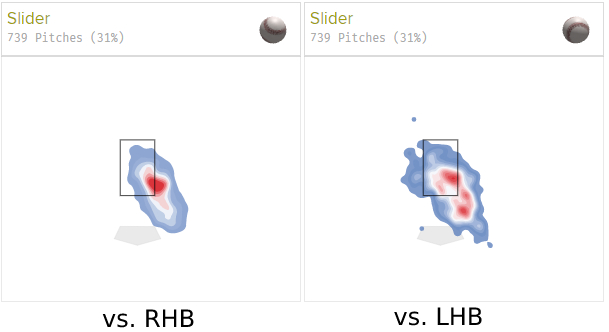
Brubaker clearly looks down and away with the slider to righties, but against lefties, he’s undecided on if he wants to throw it as a backfoot pitch or in the zone. The reason for the high variance in location for lefties is that he doesn’t really have a good pitch for facing lefties. The sinker is used to jam righties, but not so much against lefties.
While trusting PLV for a turnaround might be a bit of a stretch for Brubaker, especially in a fantasy sense, he is showing a clear area that he can improve in throughout 2023. Brubaker is yet another super deep SP that could be a target, as he’s shown bits and pieces of promise over the last few years.
Off-Speed
Lucas Giolito’s Changeup: 94th Percentile PLV & 8th Percentile Run Value
Lucas Giolito’s rise and fall has been a surprising turn of events and I don’t think many people are anticipating another year of a 4.90 ERA in 2023. While the fastball velocity dropped by two ticks, the whiffs have evaporated from Giolito’s arsenal. He went from back-to-back 32% & 33% strikeout rates in 2019 & 2020 to 28% and 25% K% in 2021 & 2022, taking him out of the elite tier of strikeout arms. One of the unique parts of his arsenal is his changeup, and it is a reason to believe in a bounceback in 2023.
PLV still believes the changeup is an elite pitch, but everything else is not great.
The changeup almost sticks out like a sore thumb, and part of its struggles could be related to the fact that all of the other pitches aren’t good enough to make the changeup convincing. However, year-to-year hard hit and whiff rates suggest otherwise.
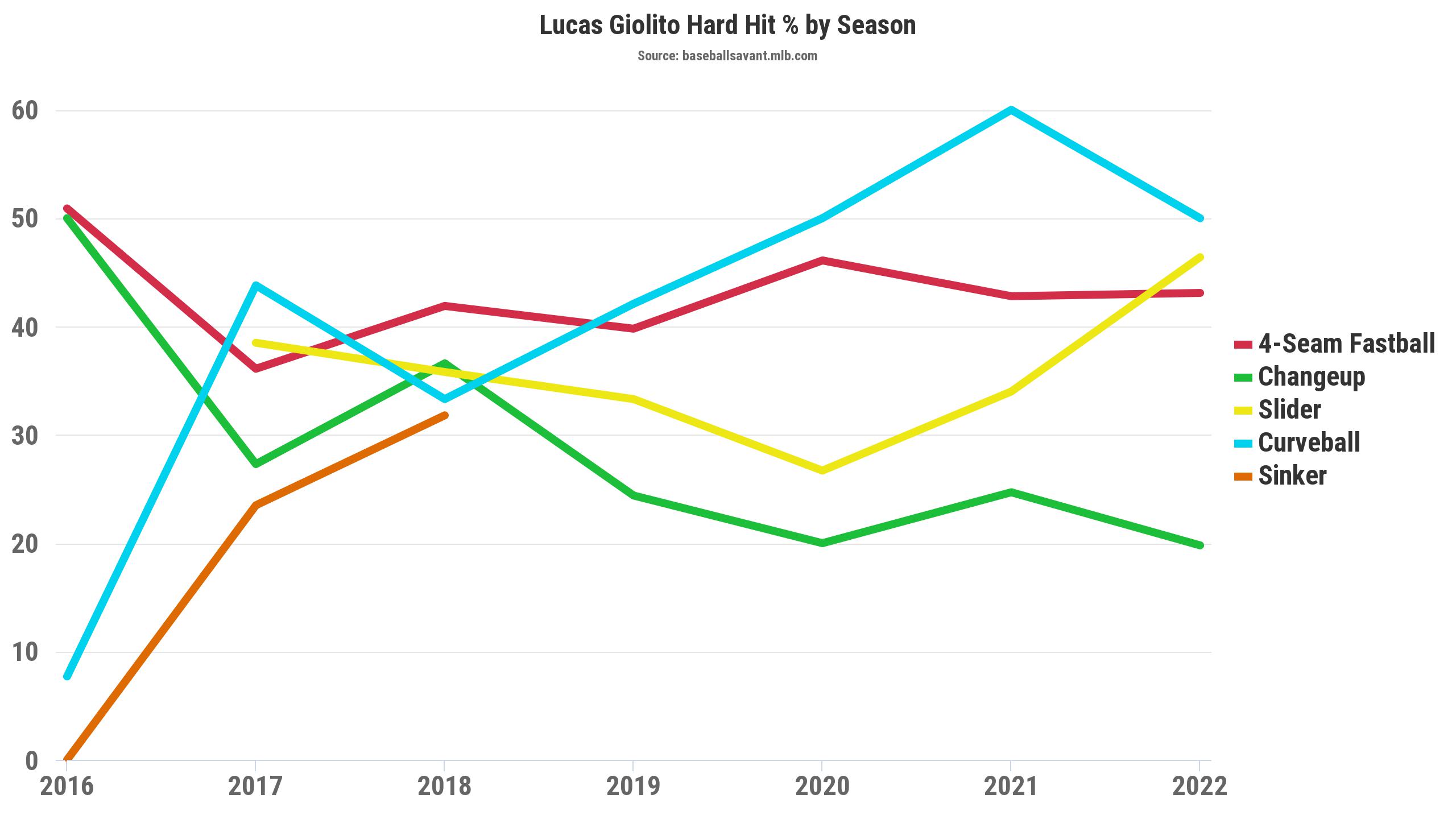
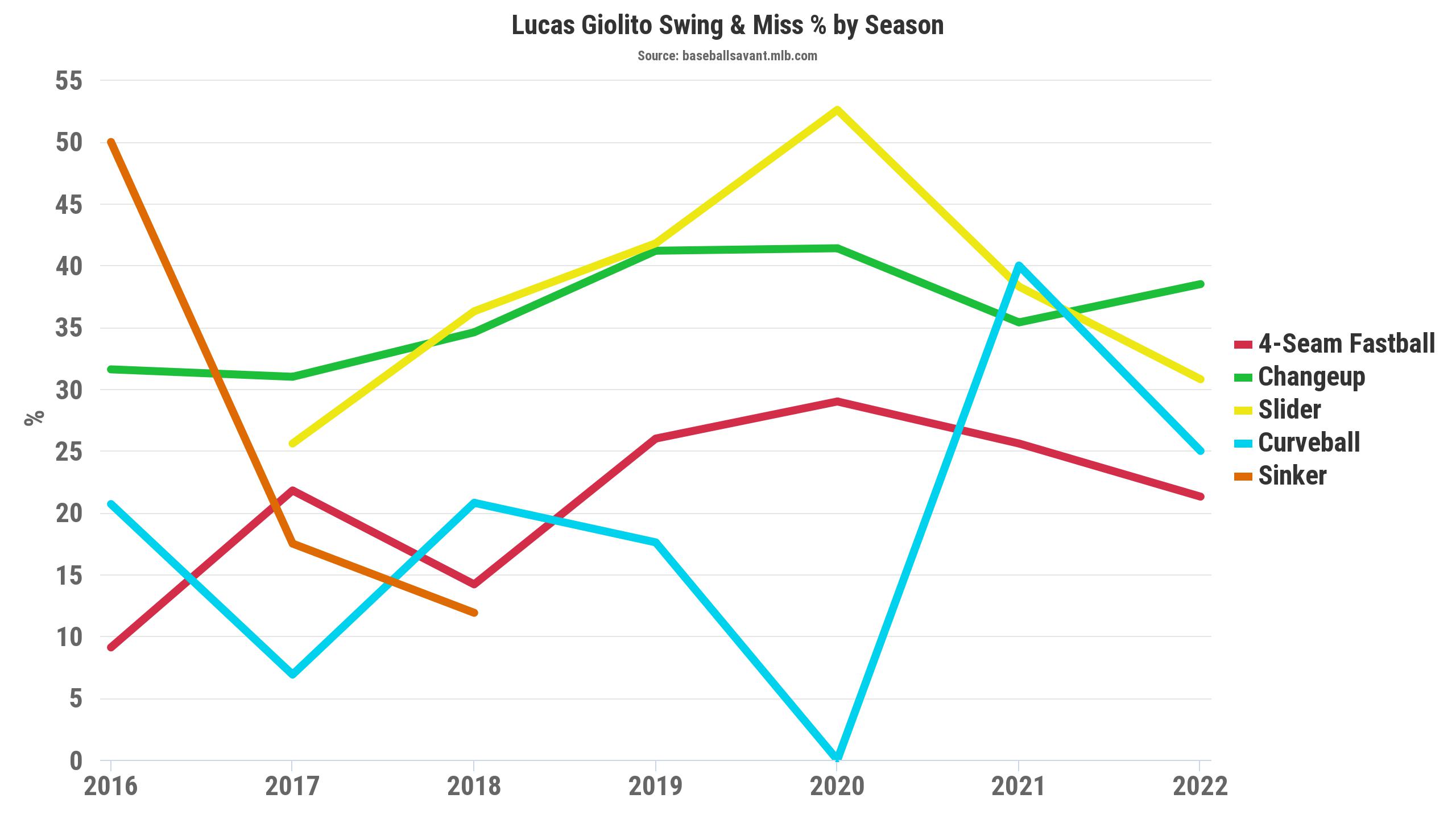
In 2022, the changeup was one of two pitches to decrease in hard-hit rate and the only pitch to increase its whiffs compared to 2021. Yet, the run value on the pitch went from -11 in 2021 to +7 in 2022. What gives?
Due to the decreasing velocity of the fastball, Giolito seemingly lost confidence in throwing it when he fell behind. That meant the changeup saw a 5% increase in usage when behind in the count. Even though the changeup was still very good, it was used in situations that were not conducive to success.
While the PLV on the changeup dropped a decent amount, it was still thrown as a quality pitch (PLV of 5.5<) at the same clip. Hit luck also suggests Giolito lost about five hits worth of luck from 2021-2022 but that does not totally account for the 82-point increase in BABIP. It is partially an unlucky BABIP due to the less-than-stellar defense behind him. Giolito needs to regain the confidence to use his fastball when necessary. The changeup remains an elite pitch, which makes him an intriguing arm in fantasy this year, but the bigger questions surround the rest of his stuff. Everything points to the changeup not being as bad as it was last year though, which should at least be one step forward.
Marco Gonzales’s Changeup: 93rd Percentile PLV & 36th Percentile Run Value
The last guy that I’ll look at today is Marco Gonzales, who is a curious case for PLV. His primary pitch in 2022 was a changeup, which makes the use of it inherently weird. Gonzales’s changeup sits around 79mph, making it one of baseball’s slowest changeups, which goes along with an 89mph fastball. Albeit not pretty, this has brought Gonzales a respectable ERA over the last few seasons: his 4.13 ERA in 2022 was his highest ERA since 2017.
While the pitch mix doesn’t exactly jump off the paper, the changeup was an excellent pitch in 2022. By PLV, 5.18 ranks in the 93rd percentile, and Gonzales is able to obtain a ton of whiffs. A 46.9% chase rate ranks 14th among starters with at least 300 changeups thrown. Furthermore, he locates the pitch effectively with a 109 Location+ that ranks sixth among pitchers with at least 120 IP. However, because a changeup is Gonzales’s main offering, it ends up getting hit around more often than it would if it were a secondary. It gave up slightly more hits than average in 2022 but expected stats show that is a slight underperformance. With a high volume changeup, it checks out that the pitch was unlucky because there is a greater chance of the hitters lucking into a hit than vice versa.
Gonzales could return a serviceable ERA in 2023 likely by throwing fewer changeups. While it is his bread and butter, their efficacy is still tied to the other pitches, which changed in usage last season. Gonzales swapped out a majority of his sinker usage for a four-seam fastball, increased cutter usage, and, of course, increased changeup usage. He tried to throw more strikes with the cutter than in previous years, but the cutter was a significantly below-average pitch. He could benefit from returning to the sinker, as the Mariners did gain elite defender Kolten Wong at second base.
Featured Image by Kurt Wasemiller (@KUWasemiller on Twitter) | Photo by Leslie Plaza Johnson | Icon Sportswire
